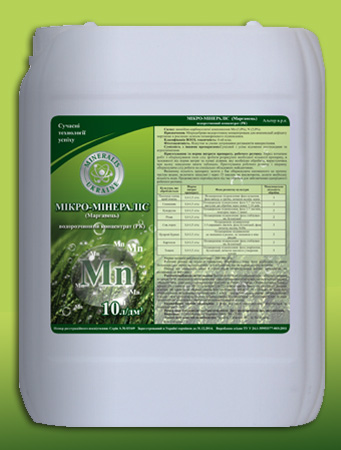 Micro-Міneralis (Manganese) is a versatile and easily digestible liquid microfertilizer intended for foliar fertilizing of agricultural crops that are sensitive to lack of manganese.
Micro-Міneralis (Manganese) is a versatile and easily digestible liquid microfertilizer intended for foliar fertilizing of agricultural crops that are sensitive to lack of manganese.
Micro-Мineralis (Manganese) microfertilizer composition
аmmonium-carboxylate chelates, %
| Mn |
N |
|
3,0 |
2,0 |
Manganese in plants life
Manganese activates enzymes in plants, accumulates in leaves and participates in photolysis of water. Being a component of photosystem, it contributes to accumulation and movement of sugar from leaves to roots, stimulates growth of new tissues in growth points, improves absorption of iron from soil and prevents chlorosis. If it is absent, release of oxygen during photosynthesis and carbohydrate content, especially in the roots, are sharply reduced.
Crops, sensitive to manganese deficiency, are winter and spring cereals, soya, sugar beets, fodder beets and red beets, corn, potatoes, apples. Inflow of manganese in plants is reduced at low temperatures and high humidity of soil, which is mostly often observed in early
spring, when winter crops are especially exposed.
Introduction of Micro-Міneralis (Manganese) increases synthesis of vitamin C, carotene and glutamine in fruit and vegetable crops, increases sugar content of sugar beets, improves fixation of atmospheric nitrogen by nodule bacteria of legumes.
Usage
Application rates of Micro-Міneralis (Manganese)
| Processed culture |
Application rate |
Stage of culture development |
Maximum number of |
|
Winter wheat, |
1,0-1,5 l/ha |
tillering stage, booting stage, |
3 |
|
Sunflower |
1,0-1,5 l/ha |
stage of 5-7 pairs of leaves, two following processing every 7-10 days |
2 |
|
Corn |
1,0-1,5 l/ha |
stage of 3-7 leaves, repeat in 2 weeks |
2 |
|
Rapeseed |
1,0-1,5 l/ha |
booting stage, budding stage |
2 |
|
Soya, peas |
1,0-1,5 l/ha |
3-5 leaves, budding stage, |
3 |
|
Sugar beet |
1,0-1,5 l/ha |
Before closing of crops, |
2 |
|
Potato |
1,0-1,5 l/ha |
Foliar fertilizing: booting stage, budding stage |
2 |
|
Tomatoes |
1,0-1,5 l/ha |
Foliar fertilizing: rooting stage, budding stage, beginning of massive fruits’ formation |
3 |
Application rates of working solution: 200-300 l/ha for field crops.




